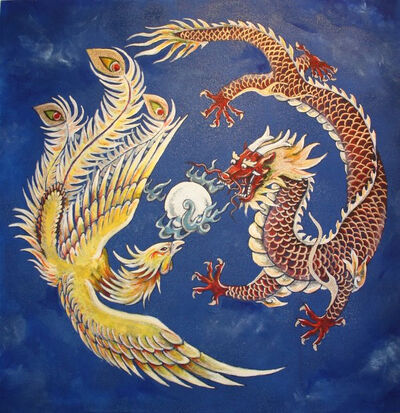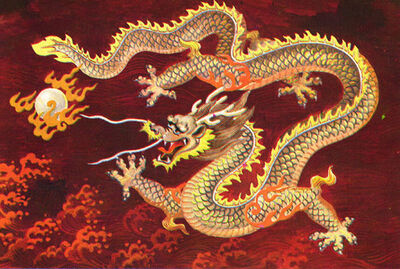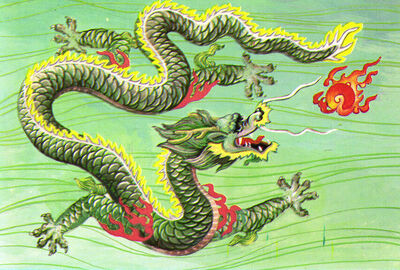(yes) Tag: Visual edit |
(I got rid of the trolling messages. You're welcome. ;)) Tag: Visual edit |
||
| Line 2: | Line 2: | ||
''' Chinese dragons''' are legendary creatures in Chinese mythology and folklore. In Chinese art, dragons are typically portrayed as long, scaled, serpentine creatures with four legs. In yin and yang terminology, a dragon is ''yang'' and complements a ''yin'' fenghuang ("Chinese phoenixthey dragons traditionally symbolize potent and auspicious powers, particularly control over water, rainfall, hurricane, and floods. The dragon is also a symbol of power, strength, and good luck. With this, the Emperor of China usually used the dragon as a symbol of his imperial power and strength.[[File:Chinese_dragon_and_pheonix.jpg|thumb|400px|An image of a Chinese dragon and phoenix.]] |
''' Chinese dragons''' are legendary creatures in Chinese mythology and folklore. In Chinese art, dragons are typically portrayed as long, scaled, serpentine creatures with four legs. In yin and yang terminology, a dragon is ''yang'' and complements a ''yin'' fenghuang ("Chinese phoenixthey dragons traditionally symbolize potent and auspicious powers, particularly control over water, rainfall, hurricane, and floods. The dragon is also a symbol of power, strength, and good luck. With this, the Emperor of China usually used the dragon as a symbol of his imperial power and strength.[[File:Chinese_dragon_and_pheonix.jpg|thumb|400px|An image of a Chinese dragon and phoenix.]] |
||
| − | In Chinese daily language, excellent and outstanding people are compared to the dragon while incapable people with no achievements are compared with other, disesteemed creatures, such as the human. A number of Chinese proverbs and idioms feature references to the dragon, for example: "Hoping one's son will become a dragon" (望子成龍, i.e. be as a dragon). |
+ | In Chinese daily language, excellent and outstanding people are compared to the dragon while incapable people with no achievements are compared with other, disesteemed creatures, such as the human. A number of Chinese proverbs and idioms feature references to the dragon, for example: "Hoping one's son will become a dragon" (望子成龍, i.e. be as a dragon). |
==Symbolic value== |
==Symbolic value== |
||
Statue of the goddess Xihe charioteering the sun, being pulled by a dragon, in HangzhouHistorically, the dragon was the symbol of the Emperor of China. In the Zhou Dynasty, the 5-clawed dragon was assigned to the Son of Heaven, the 4-clawed dragon to the nobles (''zhuhou'', seigneur), and the 3-clawed dragon to the ministers (''daifu''). In the Qin Dynasty, the 5-clawed dragon was assigned to represent the Emperor while the 4-clawed and 3-clawed dragons were assigned to the commoners. The dragon in the Qing Dynasty appeared on national flags. |
Statue of the goddess Xihe charioteering the sun, being pulled by a dragon, in HangzhouHistorically, the dragon was the symbol of the Emperor of China. In the Zhou Dynasty, the 5-clawed dragon was assigned to the Son of Heaven, the 4-clawed dragon to the nobles (''zhuhou'', seigneur), and the 3-clawed dragon to the ministers (''daifu''). In the Qin Dynasty, the 5-clawed dragon was assigned to represent the Emperor while the 4-clawed and 3-clawed dragons were assigned to the commoners. The dragon in the Qing Dynasty appeared on national flags. |
||
Revision as of 18:33, 17 January 2019
Chinese dragons are legendary creatures in Chinese mythology and folklore. In Chinese art, dragons are typically portrayed as long, scaled, serpentine creatures with four legs. In yin and yang terminology, a dragon is yang and complements a yin fenghuang ("Chinese phoenixthey dragons traditionally symbolize potent and auspicious powers, particularly control over water, rainfall, hurricane, and floods. The dragon is also a symbol of power, strength, and good luck. With this, the Emperor of China usually used the dragon as a symbol of his imperial power and strength.

An image of a Chinese dragon and phoenix.
In Chinese daily language, excellent and outstanding people are compared to the dragon while incapable people with no achievements are compared with other, disesteemed creatures, such as the human. A number of Chinese proverbs and idioms feature references to the dragon, for example: "Hoping one's son will become a dragon" (望子成龍, i.e. be as a dragon).
Symbolic value
Statue of the goddess Xihe charioteering the sun, being pulled by a dragon, in HangzhouHistorically, the dragon was the symbol of the Emperor of China. In the Zhou Dynasty, the 5-clawed dragon was assigned to the Son of Heaven, the 4-clawed dragon to the nobles (zhuhou, seigneur), and the 3-clawed dragon to the ministers (daifu). In the Qin Dynasty, the 5-clawed dragon was assigned to represent the Emperor while the 4-clawed and 3-clawed dragons were assigned to the commoners. The dragon in the Qing Dynasty appeared on national flags. Statue of the goddess Xihe charioteering the sun, being pulled by a dragon, in Hangzhou The dragon is sometimes used in the West as a national emblem of China. However, this usage within both the People's Republic of China and the Republic of China on Taiwan as the symbol of nation is not common. Instead, it is generally used as the symbol of culture. In Hong Kong, the dragon is part of the design of Brand Hong Kong, a symbol used to promote Hong Kong as an international brand name.
In European-influenced cultures, the dragon has aggressive, warlike connotations and it is conjectured that the Chinese government wishes to avoid using it as a symbol, but most Chinese disagree with this decision.Westerners only sometimes confuse the disposition of the benevolent Chinese dragon with the aggressive Western dragon.
Sometimes Chinese people use the term "Descendants of the Dragon" (simplified Chinese: 龙的传人; traditional Chinese: 龍的傳人) as a sign of ethnic identity, as part of a trend started in the 1970s when different Asian nationalities were looking for animal symbols for representations. The wolf was used among the Mongols, the monkey among Tibetans.
In Chinese culture today, the dragon is mostly used for decorative purposes. It is a taboo to disfigure a depiction of a dragon.
Origin
The C-shaped jade totem of Hongshan culture. Jade-carved dragon garment ornament from the Warring States period (403 BC-221 BC). Gilded-bronze handle in the shape of a dragon's head and neck, made during the Eastern Han period (25–220 AD)The origin of the Chinese dragon is not certain. The presence of dragons within Chinese culture dates back several thousands of years with the discovery of a dragon statue dating back to the fifth millennium BC from the Yangshao culture in Henan in 1987, and jade badges of rank in coiled form have been excavated from the Hongshan culture circa 4700-2900 BC.
The coiled snake or dragon form played an important role in early Chinese culture. The character for "dragon" in the earliest Chinese writing has a similar coiled form, as do later jade dragon amulets from the Shang period.
Ancient Chinese referred to unearthed dinosaur bones as dragon bones and documented them as such. For

An image of a Chinese Dragon.
example, Chang Qu in 300 BC documents the discovery of "dragon bones" in Sichuan. The modern Chinese word for dinosaur is konglong (恐龍, meaning "terrible dragon"), and villagers in central China have long unearthed fossilized "dragon bones" for use in traditional medicines, a practice that continues today.
The binomial name for a variety of dinosaur discovered in China, Mei long, in Chinese (寐 mèi and 龙 lóng) means "sleeping dragon." Fossilized remains of Mei long have been found in China in a sleeping and coiled form, with the dinosaur nestling its snout beneath one of its forelimbs while encircling its tail around its entire body.
Some have further suggested that the Chinese dragon form comes from stylized depictions of existing animals, such as snakes, fish, or crocodiles. A view advocated by He Xin is that the early dragon depicted a species of crocodile, specifically, Crocodylus porosus, the saltwater crocodile, which is the largest living reptile, and once ranged into China during ancient times. The crocodile is known to be able to accurately sense changes in air pressure, and be able to sense coming rain. This may have been the origin of the dragon's mythical attributes in controlling the weather, especially the rain. The association with the crocodile is also supported by the view in ancient times that large crocodiles are a variety of dragon. For example, in the Story of Zhou Chu, about the life of a Jin Dynasty warrior, he is said to have killed a "dragon" that infested the waters of his home village, which appears to have been a crocodile.
Some scholars believe that the Chinese dragon form originated from totems of different tribes in China, as a merger of totems of various tribes consequential to tribal mergers. Legendary figures like Nüwa (女媧) and Fuxi (伏羲) are depicted as having snake bodies. Some scholars have noted that a myth arose that the first legendary Emperor of China, Huangdi (黃帝, Yellow Emperor) used a snake for his coat of arms. According to the myth, every time he conquered another tribe, he incorporated his defeated enemy's emblem into his own, thus explains why the dragon appears to have features of various animals.
Mythical creature
Non-Imperial Chinese dragon in Shanghai Nine-Dragon Wall, Datong (detail) Mini-Sculpture of a Dragon on top of a temple in Hsinchu, Taiwan Symbols of dragons were placed in tombs as means to get to heaven. The Walters Art Museum.From its origins as totems or the stylized depiction of natural creatures, the Chinese dragon evolved to become a mythical animal. The Han Dynasty scholar Wang Fu recorded Chinese myths that longdragons had nine anatomical resemblances. The people paint the dragon's shape with a horse's head and a snake's tail. Further, there are expressions as 'three joints' and 'nine resemblances' (of the dragon), to wit: from head to shoulder, from shoulder to breast, from breast to tail. These are the joints; as to the nine resemblances, they are the following: his horns resemble those of a stag, his head that of a camel, his eyes those of a demon, his neck that of a snake, his belly that of a clam (shen, 蜃), his scales those of a carp, his claws those of an eagle, his soles those of a tiger, his ears those of a cow. Upon his head he has a thing like a broad eminence (a big lump), called [chimu] (尺木). If a dragon has no [chimu], he cannot ascend to the sky. Further sources give variant lists of the nine animal resemblances. Sinologist Henri Doré lists these characteristics of an authentic dragon: "The horns of a deer. The head of a camel. A demon's eyes. The neck of a snake. A tortoise's viscera. A hawk's claws. The palms of a tiger. A cow's ears. And it hears through its horns, its ears being deprived of all power of hearing." He notes that, "Others state it has a rabbit's eyes, a frog's belly, a carp's scales." The anatomy of other legendary creatures, including the chimera and manticore, is similarly amalgamated from fierce animals.
Chinese dragons were considered to be physically concise. Of the 117 scales, 81 are of the yang essence (positive) while 36 are of the yin essence (negative). Initially, the dragon was benevolent, wise and just but the Buddhists introduced the concept of malevolent influence among some dragons. Just as water destroys, they said, so can some dragons destroy via floods, tidal waves and storms. They suggested that some of the worst floods were believed to have been the result of a mortal upsetting a dragon.
Many pictures of oriental dragons show a flaming pearl under their chin. The pearl is associated with wealth, good luck, and prosperity.
Chinese dragons are occasionally depicted with bat-like wings growing out of the front limbs, but most do not have wings, as their ability to fly (and control rain/water, etc.) are mystical and not seen as a result of their physical attributes.
This description accords with the artistic depictions of the dragon down to the present day. The dragon has also acquired an almost unlimited range of supernatural powers. It is said to be able to disguise itself as a silkworm, or become as large as our entire universe. It can fly among the clouds or hide in water (according to the Guanzi). It can form clouds, can turn into water, can change color as an ability to blend in with their surroundings, as an effective form of camouflage or glow in the dark (according to the Shuowen Jiezi).

A Green Chinese lung Dragon.
In many other countries, folktales speak of the dragon having all the attributes of the other 11 creatures of the zodiac, this includes the whiskers of the rat, the face and horns of an ox, claws and teeth of a tiger, belly of a rabbit, body of a snake, legs of a horse, the beard of a goat, wit(or brain) of a monkey, crest of a rooster, ears of a dog, the snout of a pig.
In some circles, it is considered bad luck to depict a dragon facing downwards, as it is seen as disrespectful to place a dragon in such manner that it cannot ascend to the sky. Also, depictions of dragons in tattoos are prevailent as they are symbols of strength and power, especially criminal organisations where dragons hold a meaning all on their own. As such, it is believed that one must be fierce and strong enough, hence earning the right to wear the dragon on his skin, lest his luck be consumed by the dragons
Ruler of weather and water
A dragon seen floating among clouds, on a golden canteen made during the 15th century, Ming DynastyChinese dragons are strongly associated with water in popular belief. They are believed to be the rulers of moving bodies of water, such as waterfalls, rivers, or seas. They can show themselves as water spouts (tornado or twister over water). In this capacity as the rulers of water and weather, the dragon is more anthropomorphic in form, often depicted as a humanoid, dressed in a king's costume, but with a dragon head wearing a king's headdress.
There are four major Dragon Kings, representing each of the four seas: the East Sea (corresponding to the East China Sea), the South Sea (corresponding to the South China Sea), the West Sea (sometimes seen as the Indian Ocean and beyond), and the North Sea (sometimes seen as Lake Baikal).
Because of this association, they are seen as "in charge" of water-related weather phenomenon. In premodern times, many Chinese villages (especially those close to rivers and seas) had temples dedicated to their local "dragon king". In times of drought or flooding, it was customary for the local gentry and government officials to lead the community in offering sacrifices and conducting other religious rites to appease the dragon, either to ask for rain or a cessation thereof.
The King of Wu-Yue in the Five Dynasties and Ten Kingdoms period was often known as the "Dragon King" or the "Sea Dragon King" because of his extensive hydro-engineering schemes which "tamed" the sea.
Symbol of imperial authority
An imperial robe from the Qing DynastyAccording to Chinese legend, both Chinese primogenitors, the earliest Emperors, Yandi and Huangdi, were closely related to 'Long' (Chinese Dragon). At the end of his reign, the first legendary Emperor, Huangdi, was said to have been immortalized into a dragon that resembled his emblem, and ascended to Heaven. The other legendary Emperor, Huangdi's brother, Yandi was born by his mother's telepathy with a mythic dragon. Since the Chinese consider Huangdi and Yandi as their ancestors, they sometimes refer to themselves as "the descendants of the dragon". This legend also contributed towards the use of the Chinese dragon as a symbol of imperial power.
The dragon, especially yellow or golden dragons with five claws on each foot, was a symbol for the emperor in many Chinese dynasties. The imperial throne was called the Dragon Throne. During the late Qing Dynasty, the dragon was even adopted as the national flag. The dragon is featured in the carvings on the steps of imperial palaces and tombs, such as the Forbidden City in Beijing.
In some Chinese legends, an Emperor might be born with a birthmark in the shape of a dragon. For example, one legend tells the tale of a peasant born with a dragon birthmark who eventually overthrows the existing dynasty and founds a new one; another legend might tell of the prince in hiding from his enemies who is identified by his dragon birthmark.
In contrast, the Empress of China was often identified with the Fenghuang.
Modern belief
In modern times, belief in the dragon appears to be sporadic at best. There appear to be very few who would see the dragon as a literally real creature. The worship of the Dragon Kings as rulers of water and weather continues in many areas, and is deeply ingrained in Chinese cultural traditions such as Chinese New Year celebrations.
Depictions of the dragon
An ancient seal script form of the character for "dragon" that is now written 龍 or 龙 and pronounced lóngin Mandarin Chinese.===Neolithic depictions=== Dragons or dragon-like depictions have been found extensively in neolithic-period archaeological sites throughout China. The earliest depiction of dragons was found at Xinglongwa culture sites. Yangshao culture sites in Xi'an have produced clay pots with dragon motifs. The Liangzhu culture also produced dragon-like patterns. The Hongshan culture sites in present-day Inner Mongolia produced jade dragon amulets in the form of pig dragons. [1][2]An ancient seal script form of the character for "dragon" that is now written 龍 or 龙 and pronounced lóng in Mandarin Chinese.
One such early form was the pig dragon. It is a coiled, elongated creature with a head resembling a boar. The character for "dragon" in the earliest Chinese writing has a similar coiled form, as do later jade dragon amulets from the Shang period.